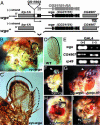Involvement of winged eye encoding a chromatin-associated bromo-adjacent homology domain protein in disc specification
- PMID: 16247005
- PMCID: PMC1276095
- DOI: 10.1073/pnas.0507945102
Involvement of winged eye encoding a chromatin-associated bromo-adjacent homology domain protein in disc specification
Abstract
How organ identity is determined is a fundamental question in developmental biology. In Drosophila, field-specific selector genes, such as eyeless (ey) for eyes and vestigial (vg) for wings, participate in the determination of imaginal disc-specific identity. We performed gain-of-function screening and identified a gene named winged eye (wge), which encodes a bromo-adjacent homology domain protein that localizes at specific sites on chromosomes in a bromo-adjacent homology domain-dependent manner. Overexpression of wge-induced ectopic wings with antero-posterior and dorso-ventral axes in the eye field in a region-specific Hox gene-(Antennapedia) independent manner. Overexpression of wge was sufficient for ectopic expression of vg in eye discs. A context-dependent requirement of wge was demonstrated for vg expression in wing discs and for expression of eyes absent (eya), a control gene for eye development downstream of ey, in eye discs. In contrast to vg, however, overexpression of wge inhibited EY-mediated expression of eya. Consistent with colocalization on polytene chromosomes of WGE and Posterior sex combs (PSC), a Polycomb group gene product, we demonstrated an antagonistic genetic interaction between wge and Psc. These findings suggest that wge functions in the determination of disc-specific identity, downstream of Hox genes.
Figures




Similar articles
-
Eyeless collaborates with Hedgehog and Decapentaplegic signaling in Drosophila eye induction.Dev Biol. 2003 Apr 1;256(1):49-60. doi: 10.1016/s0012-1606(02)00123-9. Dev Biol. 2003. PMID: 12654291
-
winged eye Induces Transdetermination of Drosophila Imaginal Disc by Acting in Concert with a Histone Methyltransferase, Su(var)3-9.Cell Rep. 2018 Jan 2;22(1):206-217. doi: 10.1016/j.celrep.2017.11.105. Cell Rep. 2018. PMID: 29298422
-
Organ identity specification factor WGE localizes to the histone locus body and regulates histone expression to ensure genomic stability in Drosophila.Genes Cells. 2016 May;21(5):442-56. doi: 10.1111/gtc.12354. Epub 2016 Mar 8. Genes Cells. 2016. PMID: 27145109
-
The wing and the eye: a parsimonious theory for scaling and growth control?Wiley Interdiscip Rev Dev Biol. 2015 Nov-Dec;4(6):591-608. doi: 10.1002/wdev.195. Epub 2015 Jun 24. Wiley Interdiscip Rev Dev Biol. 2015. PMID: 26108346 Review.
-
The genetic control of organ growth: insights from Drosophila.Curr Opin Genet Dev. 2000 Feb;10(1):75-80. doi: 10.1016/s0959-437x(99)00042-8. Curr Opin Genet Dev. 2000. PMID: 10679387 Review.
Cited by
-
Polycomb group (PcG) proteins and Pax6 cooperate to inhibit in vivo reprogramming of the developing Drosophila eye.Development. 2018 Apr 4;145(7):dev160754. doi: 10.1242/dev.160754. Development. 2018. PMID: 29530880 Free PMC article.
-
Polycomb safeguards imaginal disc specification through control of the Vestigial-Scalloped complex.Development. 2023 Sep 15;150(18):dev201872. doi: 10.1242/dev.201872. Epub 2023 Sep 25. Development. 2023. PMID: 37702007 Free PMC article.
-
Polycomb safeguards imaginal disc specification through control of the Vestigial-Scalloped complex.bioRxiv [Preprint]. 2023 Apr 12:2023.04.11.536444. doi: 10.1101/2023.04.11.536444. bioRxiv. 2023. Update in: Development. 2023 Sep 15;150(18):dev201872. doi: 10.1242/dev.201872. PMID: 37090526 Free PMC article. Updated. Preprint.
-
A gain-of-function screen to identify genes that reduce lifespan in the adult of Drosophila melanogaster.BMC Genet. 2014 Apr 16;15:46. doi: 10.1186/1471-2156-15-46. BMC Genet. 2014. PMID: 24739137 Free PMC article.
-
Misexpression screen in Drosophila melanogaster aiming to reveal novel factors involved in formation of body parts.Genetics. 2007 Apr;175(4):1707-18. doi: 10.1534/genetics.106.064212. Epub 2006 Dec 18. Genetics. 2007. PMID: 17179072 Free PMC article.
References
-
- Halder, G., Callaerts, P. & Gehring, W. J. (1995) Science 267, 1788-1792. - PubMed
-
- Kim, J., Sebring, A., Esch, J. J., Kraus, M. E., Vorwerk, K., Magee, J. & Carroll, S. B. (1996) Nature 382, 133-138. - PubMed
-
- Affolter, M. & Mann, R. (2001) Science 292, 1080-1081. - PubMed
-
- Bonini, N. M., Bui, Q. T., Gray-Board, G. L. & Warrick, J. M. (1997) Development (Cambridge, U.K.) 124, 4819-4826. - PubMed
Publication types
MeSH terms
Substances
Associated data
- Actions
LinkOut - more resources
Full Text Sources
Molecular Biology Databases
Research Materials

